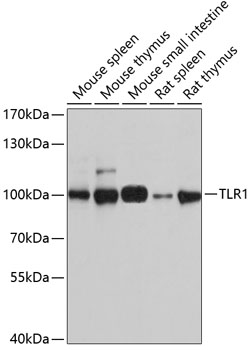Immunology Antibodies 1
Anti-TLR1 Antibody (CAB0997)
- SKU:
- CAB0997
- Product Type:
- Antibody
- Reactivity:
- Human
- Reactivity:
- Mouse
- Reactivity:
- Rat
- Host Species:
- Rabbit
- Isotype:
- IgG
- Antibody Type:
- Polyclonal Antibody
- Research Area:
- Immunology
Description
| Antibody Name: | Anti-TLR1 Antibody |
| Antibody SKU: | CAB0997 |
| Antibody Size: | 20uL, 50uL, 100uL |
| Application: | WB |
| Reactivity: | Human, Mouse, Rat |
| Host Species: | Rabbit |
| Immunogen: | Recombinant fusion protein containing a sequence corresponding to amino acids 30-290 of human TLR1 (NP_003254.2). |
| Application: | WB |
| Recommended Dilution: | WB 1:500 - 1:2000 |
| Reactivity: | Human, Mouse, Rat |
| Positive Samples: | Mouse spleen, Mouse thymus, Mouse small intestine, Rat spleen, Rat thymus |
| Immunogen: | Recombinant fusion protein containing a sequence corresponding to amino acids 30-290 of human TLR1 (NP_003254.2). |
| Purification Method: | Affinity purification |
| Storage Buffer: | Store at -20'C. Avoid freeze / thaw cycles. Buffer: PBS with 0.02% sodium azide, 50% glycerol, pH7.3. |
| Isotype: | IgG |
| Sequence: | DRSK NGLI HVPK DLSQ KTTI LNIS QNYI SELW TSDI LSLS KLRI LIIS HNRI QYLD ISVF KFNQ ELEY LDLS HNKL VKIS CHPT VNLK HLDL SFNA FDAL PICK EFGN MSQL KFLG LSTT HLEK SSVL PIAH LNIS KVLL VLGE TYGE KEDP EGLQ DFNT ESLH IVFP TNKE FHFI LDVS VKTV ANLE LSNI KCVL EDNK CSYF LSIL AKLQ TNPK LSNL TLNN IETT WNSF IRIL QLVW HTTV WYFS ISNV KLQG QLDF R |
| Gene ID: | 7096 |
| Uniprot: | Q15399 |
| Cellular Location: | Cell membrane, Cytoplasmic vesicle, Single-pass type I membrane protein, phagosome membrane |
| Calculated MW: | 90kDa |
| Observed MW: | 100kDa |
| Synonyms: | TLR1, CD281, TIL, TIL. LPRS5, rsc786, TIL.LPRS5 |
| Background: | The protein encoded by this gene is a member of the Toll-like receptor (TLR) family which plays a fundamental role in pathogen recognition and activation of innate immunity. TLRs are highly conserved from Drosophila to humans and share structural and functional similarities. They recognize pathogen-associated molecular patterns (PAMPs) that are expressed on infectious agents, and mediate the production of cytokines necessary for the development of effective immunity. The various TLRs exhibit different patterns of expression. This gene is ubiquitously expressed, and at higher levels than other TLR genes. Different length transcripts presumably resulting from use of alternative polyadenylation site, and/or from alternative splicing, have been noted for this gene. |
| UniProt Protein Function: | TLR1: Participates in the innate immune response to microbial agents. Cooperates with TLR2 to mediate the innate immune response to bacterial lipoproteins or lipopeptides. Acts via MYD88 and TRAF6, leading to NF-kappa-B activation, cytokine secretion and the inflammatory response. Binds MYD88 (via TIR domain). Interacts with CNPY3. Interacts (via extracellular domain) with TLR2. Ligand binding induces the formation of a heterodimer with TLR2. Ubiquitous. Highly expressed in spleen, ovary, peripheral blood leukocytes, thymus and small intestine. Belongs to the Toll-like receptor family. |
| UniProt Protein Details: | Protein type:Membrane protein, integral Chromosomal Location of Human Ortholog: 4p14 Cellular Component: phagocytic vesicle membrane; membrane; integral to plasma membrane; plasma membrane Molecular Function:transmembrane receptor activity; protein heterodimerization activity; receptor activity Biological Process: MyD88-dependent toll-like receptor signaling pathway; positive regulation of tumor necrosis factor biosynthetic process; macrophage activation; regulation of cytokine secretion; positive regulation of interleukin-6 biosynthetic process; innate immune response; immune response; detection of triacylated bacterial lipoprotein; inflammatory response; signal transduction; toll-like receptor 1 signaling pathway Disease: Leprosy, Susceptibility To, 5 |
| NCBI Summary: | The protein encoded by this gene is a member of the Toll-like receptor (TLR) family which plays a fundamental role in pathogen recognition and activation of innate immunity. TLRs are highly conserved from Drosophila to humans and share structural and functional similarities. They recognize pathogen-associated molecular patterns (PAMPs) that are expressed on infectious agents, and mediate the production of cytokines necessary for the development of effective immunity. The various TLRs exhibit different patterns of expression. This gene is ubiquitously expressed, and at higher levels than other TLR genes. Different length transcripts presumably resulting from use of alternative polyadenylation site, and/or from alternative splicing, have been noted for this gene. [provided by RefSeq, Jul 2008] |
| UniProt Code: | Q15399 |
| NCBI GenInfo Identifier: | 146291086 |
| NCBI Gene ID: | 7096 |
| NCBI Accession: | Q15399.3 |
| UniProt Secondary Accession: | Q15399,O15452, Q32MK3, Q32MK4, Q9UG90, D1CS39, D1CS41 |
| UniProt Related Accession: | Q15399 |
| Molecular Weight: | 90,291 Da |
| NCBI Full Name: | Toll-like receptor 1 |
| NCBI Synonym Full Names: | toll-like receptor 1 |
| NCBI Official Symbol: | TLR1 |
| NCBI Official Synonym Symbols: | TIL; CD281; rsc786; TIL. LPRS5 |
| NCBI Protein Information: | toll-like receptor 1 |
| UniProt Protein Name: | Toll-like receptor 1 |
| UniProt Synonym Protein Names: | Toll/interleukin-1 receptor-like protein; TIL; CD_antigen: CD281 |
| Protein Family: | Toll-like receptor |
| UniProt Gene Name: | TLR1 |
| UniProt Entry Name: | TLR1_HUMAN |







